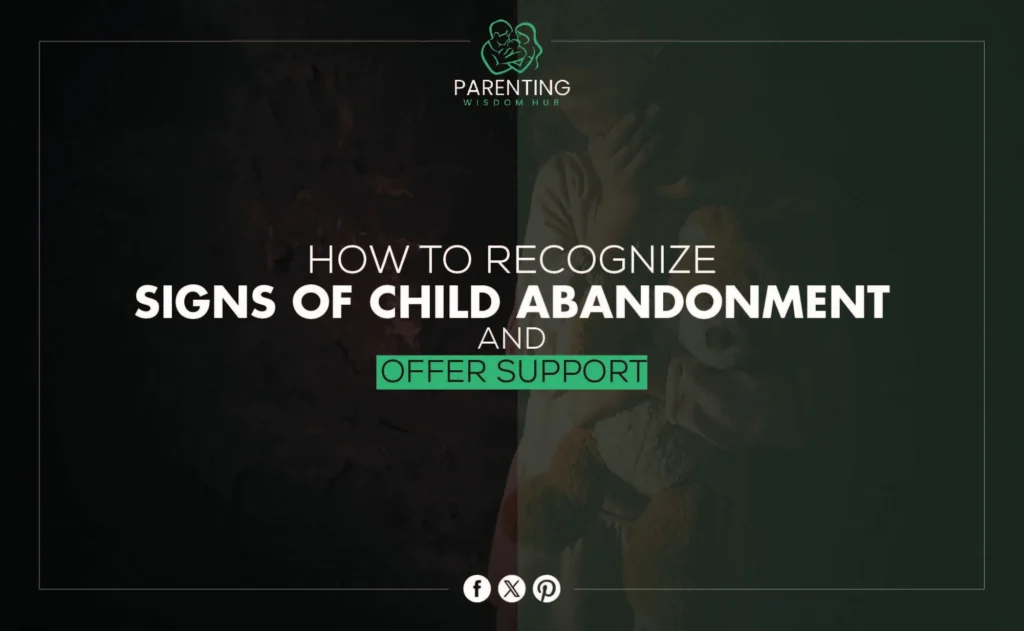Introduction
Although our society celebrates childhood, many young people experience an unsettling reality that quietly ripples through our culture. Child abandonment is a severe breach of trust that hurts a child’s mental and physical health. Due to more considerable social challenges, these youngsters are often ignored. Early detection of abandonment can save them. Understanding and tackling this issue can change lives and make us more compassionate.
Read more about Domestic Violence and its impact on children.
What is Child Abandonment?
Child abandonment refers to the act of leaving a kid without any form of care, support, or oversight. Physical abandonment, emotional neglect, or neglecting the child’s needs are examples. Intentional neglect by a parent or caregiver often results in police action.
- Physical Abandonment: A parent or guardian abandons a child without proper care, supervision, or resources for survival and well-being. This can happen in hospitals, daycares, and public venues.
- Emotional Abandonment: An emotional disconnect occurs when parents or caregivers fail to provide the love, support, and affirmation needed for healthy development. Neglect can make children feel worthless and isolated.
- Neglect: While it might overlap with abandonment, neglect is not providing a child with food, education, and medical care. A child can be physically present but emotionally or physically ignored or abandoned.
- Abandonment at Birth: Some unfortunate situations involve infants being abandoned immediately after birth owing to unwanted pregnancies or cultural taboos. The child may never feel safe and attached again.
- Parental Substance Abuse: Addict parents may unwittingly forsake their children by putting substance use above parenting. This can cause child neglect and emotional trauma.
Understanding different sorts of abandonment helps identify vulnerable children and develop effective care and intervention programs.
Causes of Child Abandonment
The terrible occurrence of child desertion has many causes. Preventing such situations requires understanding these causes. Here are some common causes:
- Socioeconomic Factors: Parents can feel overwhelmed by poverty and financial instability and choose survival over their children’s future.
- Mental Health Issues: Mental illness, like depression and anxiety, can make it hard for a caregiver to give the right amount of support and care, which can lead to psychological or physical abandonment.
- Lack of Support Systems: Families that can’t get social or community help may find it hard to handle the demands of parenting, which makes it more likely that children will be abandoned.
- Unplanned Pregnancies: Parents who are young or not ready may feel like they aren’t prepared for parenting responsibilities, which is why some leave their babies to give them a better chance.
- Substance Abuse: Addiction can make it hard for a parent to put their child’s needs first, which can lead to neglect or loss.
- Cultural Stigma: Cultural or social forces in some places may cause children who are seen as a burden to be left behind, especially if they were born outside of marriage or have disabilities.
- Domestic Violence: Parents who are leaving violent relationships may leave their kids behind to get away from danger, which puts both them and their kids in dangerous situations.
Understanding these complicated reasons might help design community initiatives and solutions to help struggling families avoid abandonment.
Recognizing Signs of Child Abandonment
Behavioral Signs
Finding abandoned children is essential to getting them help right away. Here are some behavioral signs that a child may be feeling abandoned:
- Withdrawal or Isolation: Abandoned children may retreat from friends and activities they once enjoyed, displaying social anxiety or reluctance to interact. They may sequester themselves to avoid emotional anguish.
- Extreme Clinginess or Fear of Separation: On the other hand, some youngsters may overcling to caretakers or authority adults, fearing abandonment. This habit often makes it hard to leave for school or daycare.
- Aggressive or Defiant Behavior: Abandoned kids may act out their anger or rebellion. They may throw tantrums, act out in school, or break house rules to reclaim control.
- Low Self-Esteem and Negative Self-Talk: A youngster may feel unlovable or inadequate and demonstrate poor self-worth. Negative self-image can impair academic performance and relationships with peers and adults.
Physical Signs of Child Abandonment
Besides emotional and behavioral indications, children may show physical signs of abandonment. Quickly identify these physical signs for immediate care. Look for these signs:
- Poor Hygiene: A deterioration in personal hygiene may suggest that a youngster is not getting enough care at home. This may involve unwashed skin, unclean clothes, or neglect.
- Malnutrition or Lack of Proper Nutrition: If a child is showing signs of malnutrition, like losing a lot of weight, not growing correctly, or just not having much energy, it’s possible that their basic food needs are not being met.
- Inappropriate Clothing: Insufficient clothing for the weather, too much clothing, or clothing that is incorrect for their age can indicate poor care. It may suggest a lack of money or concern about basic needs.
- Frequent Absences or Tardiness at School: Missing school or being late may indicate household concerns that could lead to abandonment or neglect. Unsupervised children may struggle to keep a school schedule.
- Unexplained Injuries or Illness: Frequently having injuries or diseases without clear explanations may suggest neglect or abandonment, especially if the child is not receiving proper medical care.
Emotional and Psychological Signs of Child Abandonment
Recognizing emotional and psychological indications of child abandonment helps provide early support. Abandoned children may experience:
- Persistent Sadness or Depression: A youngster may be tearful or withdrawn during extended melancholy. This emotional condition can make them lose interest in hobbies and social relationships.
- Heightened Anxiety and Fear: Abandoned children may have severe interpersonal and emotional anxiety. Building good relationships can be difficult when trust in others is lacking and the fear of abandonment is present.
- Mood Swings: Children who are abandoned experience fast mood shifts. They may swing between rage, grief, and hopefulness, fighting to control their emotions.
- Feelings of Guilt or Shame: Abandoned children sometimes blame themselves for their situation. Self-blame, guilt, or a continuous sense of unworthiness can lower self-esteem and self-image.
- Difficulty Expressing Emotions: Some kids have problems expressing themselves, causing irritation or outbursts. They may feel isolated because they struggle to express their emotions.
Caregivers, educators, and professionals must recognize emotional and psychological indications to help abandoned children cope and build resilience.
Long-Term Effects of Child Abandonment
Child loss can affect a person’s life, which lasts into adulthood and involves many areas. Here are some long-term effects that might happen:
- Trust Issues: People abandoned as kids may have trouble trusting others because they’re afraid they’ll leave or hurt them.
- Emotional Dysregulation: Many people may find it hard to control and express their feelings healthily, which can cause problems in their personal and work relationships.
- Low Self-Esteem: Being abandoned as a child can make a person feel worthless or inadequate for a long time, hurting their confidence and general sense of self-worth.
- Mental Health Issues: As an adult, being abandoned can make you more likely to have mental illnesses like sadness, anxiety, or post-traumatic stress disorder (PTSD).
- Difficulty Forming Healthy Relationships: Adults may find it hard to make or keep close, healthy relationships because they often repeat patterns from when they were kids and were ignored or left alone.
- Substance Abuse or Risky Behaviors: People who were abandoned as children may use drugs, alcohol, or other dangerous behaviors as ways to deal with the pain that they are still feeling.
- Attachment Issues: Many people may have insecure attachment styles, making it hard to form solid and loving relationships with others, like their children and romantic partners.
Recognizing and resolving these long-term effects is essential to helping abandonment victims heal.
How to Offer Support to an Abandoned Child
Helping an abandoned child recover and develop coping skills requires your assistance. Some practical ways to help:
- Create a Safe Environment: Create a stable and caring space for the child to feel safe and cared for. Being stable can help them trust and believe in themselves again.
- Encourage Open Communication: Create an environment where the child feels safe talking about their feelings and thoughts. Be understanding, and don’t judge them as they talk about their problems.
- Provide Consistent Care: Giving the child the same amount of care and attention over time can help them feel valued and understood. Being dependable in their daily lives can help them trust again.
- Engage in Therapeutic Activities: There are safe ways for kids to talk about their thoughts and feelings, like through art therapy, play therapy, or counseling.
- Promote Healthy Relationships: Help the child make good connections with friends and people they can trust. Positive relationships with other people can help you feel less alone.
- Be Patient and Understanding: Know that healing takes time, and be kind to the child as they work through their feelings. Understanding their journey makes the bond stronger.
- Educate Yourself: Learn about the effects of loss that might happen and how to help. Knowing more about the child can help you better understand their wants and problems.
Preventive Measures and Community Involvement
People in the community, social services, and schools all need to work together to stop child neglect and its effects. Here are some essential things to think about:
- Public Awareness Campaigns: To build empathy and proactive support systems teach the community about the reasons and effects of child abandonment.
- Support for Vulnerable Families: Set up programs to help needy families with money and mental support. This will give them the tools to stay together and lower the risk of abandonment.
- Access to Mental Health Resources: Make sure that families can get mental health services to deal with problems like sadness, addiction, or problems between family members that might lead to abandonment.
- Strengthening Child Welfare Services: Support well-funded child welfare systems that can help families in trouble by providing a wide range of support and intervention methods.
- Community Mentorship Programs: Set up mentorship programs that pair at-risk teens and young adults with caring adults who can help them feel like they fit and advise them.
- Schools as Safe Havens: Teach teachers to spot when a child is having a hard time and ensure that all students feel safe and supported when they need help.
Conclusion
Child abandonment affects emotional well-being, mental health, and relationships in individuals and communities. Understanding abandonment’s intricacies and supporting affected children can help them recover and thrive. The community and government must collaborate to prevent child abandonment and assist weak families before calamities. Awareness, education, and involvement can make children’s environments safer and more compassionate, breaking the abandoning cycle.


